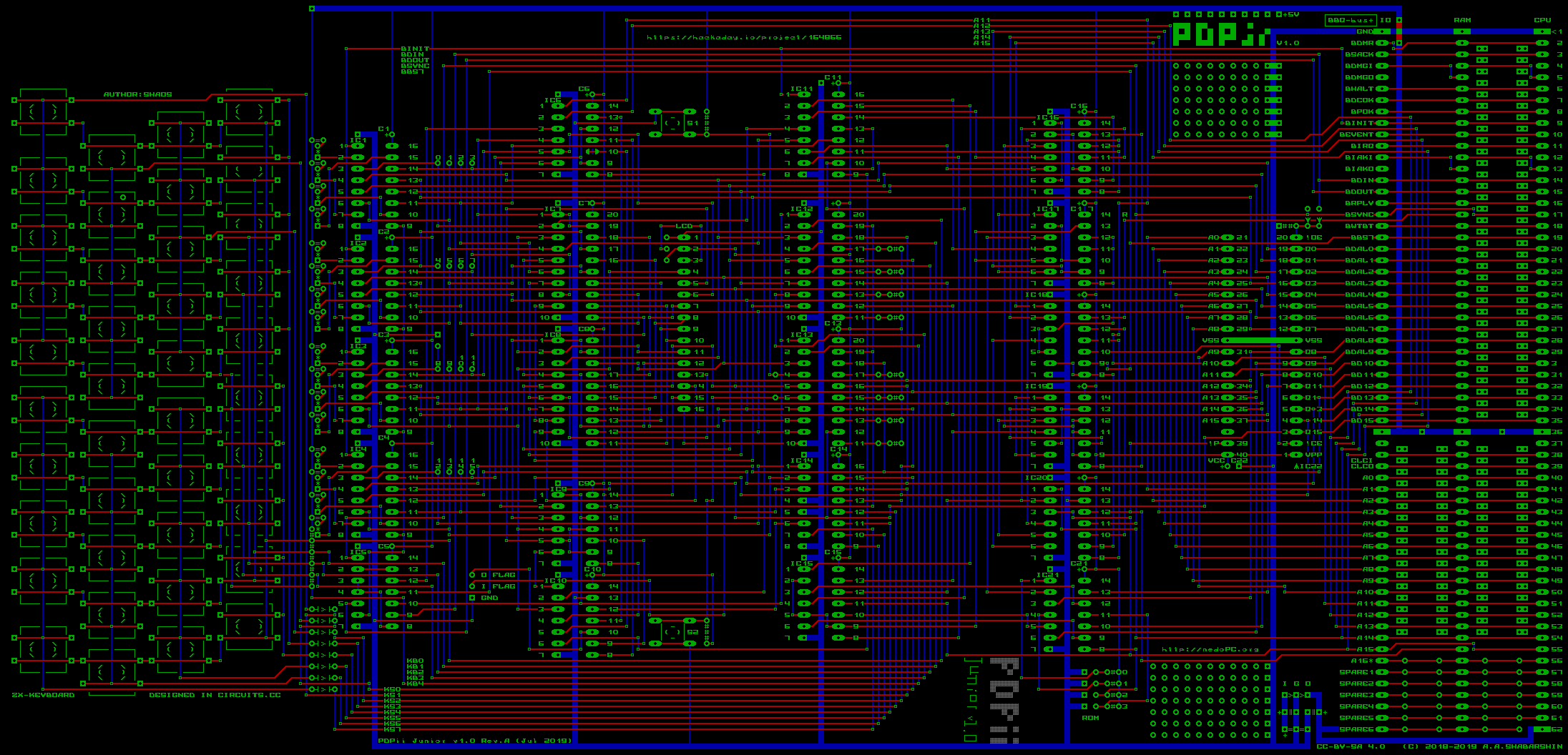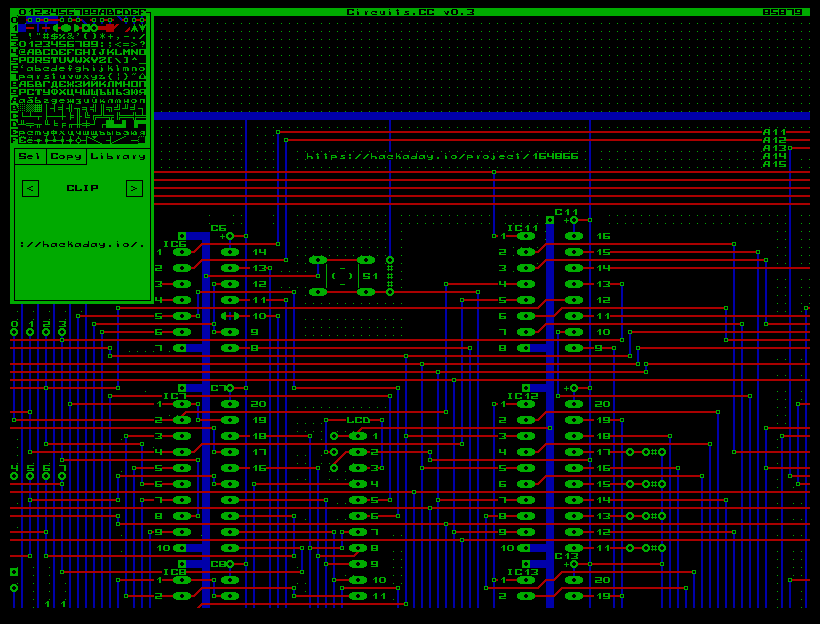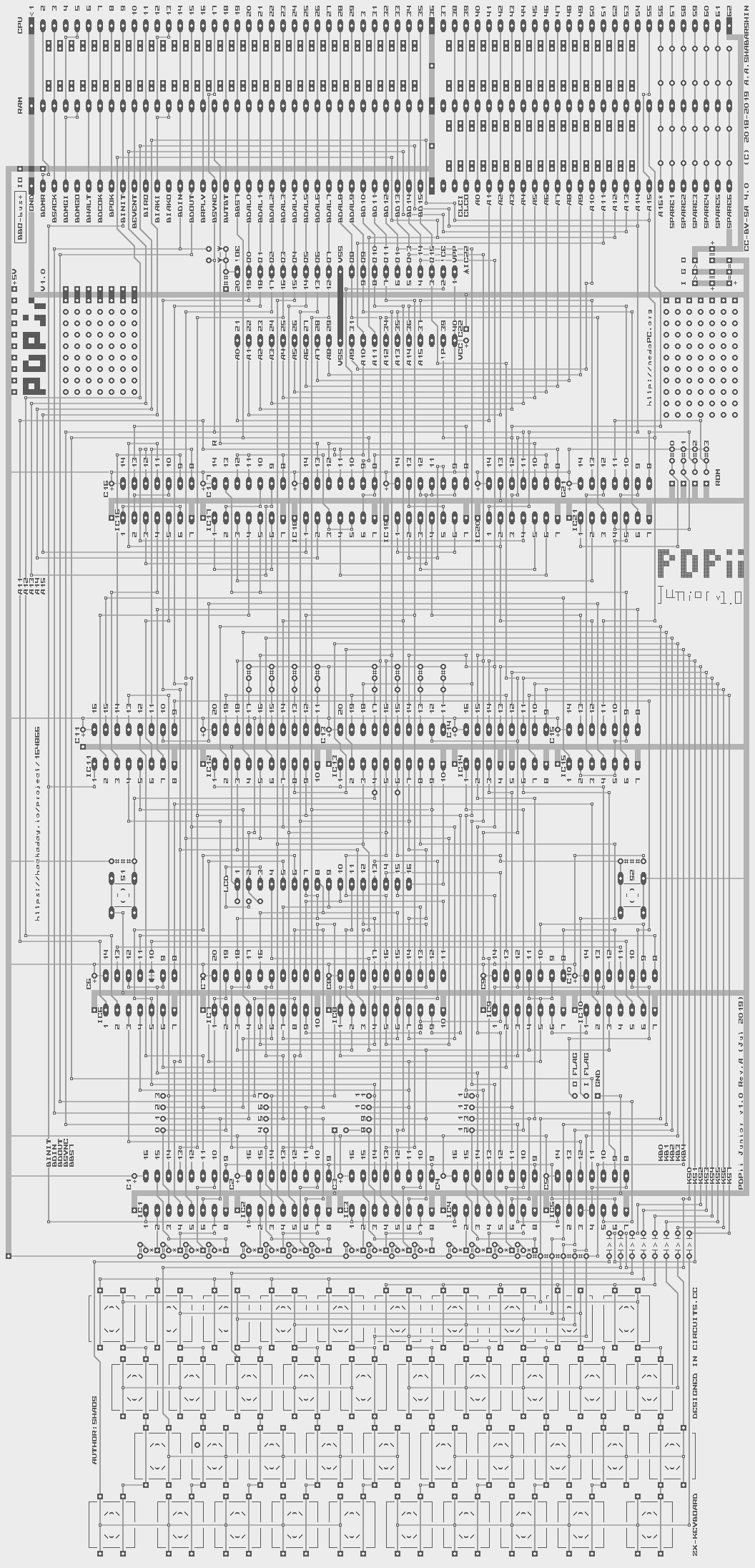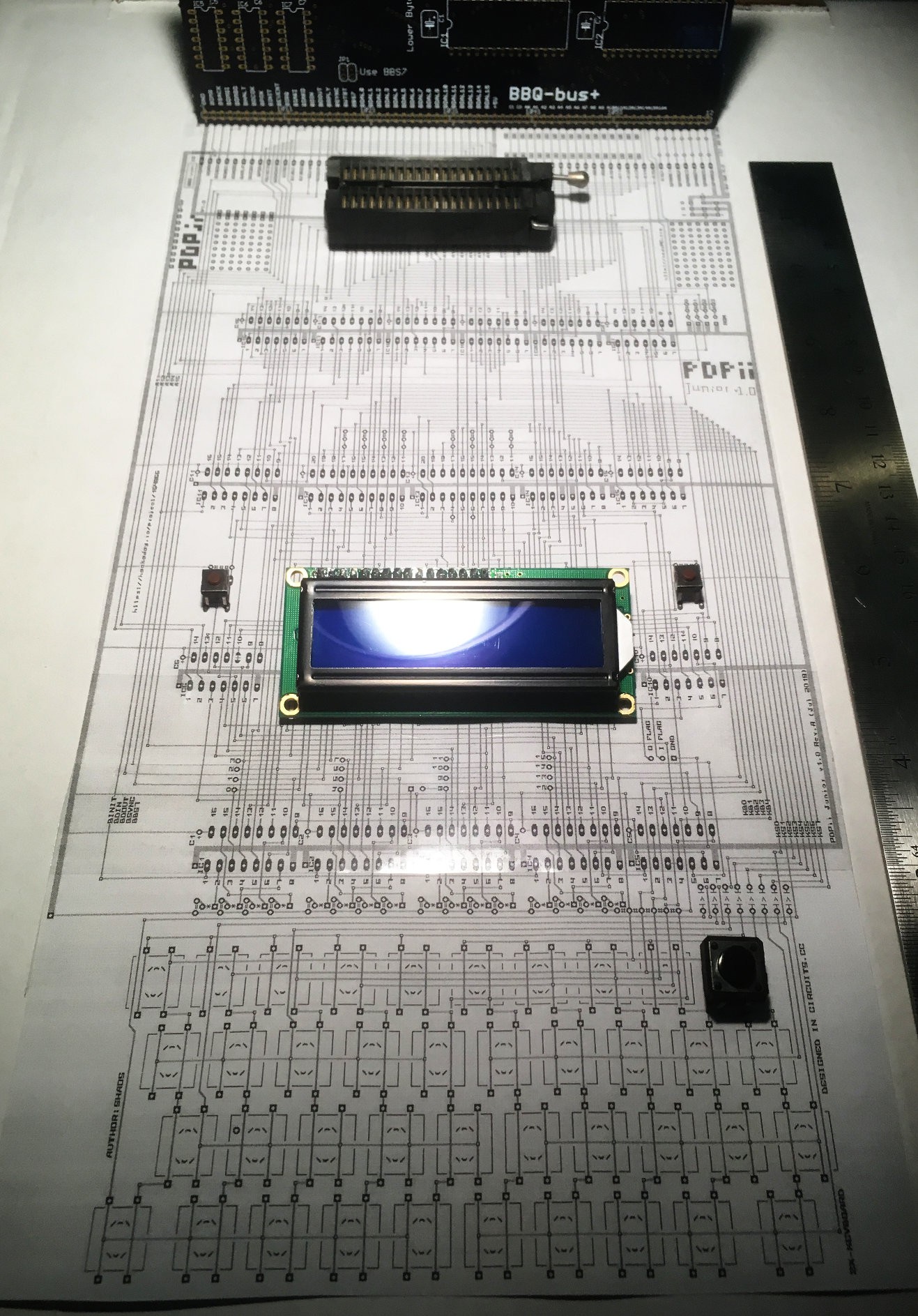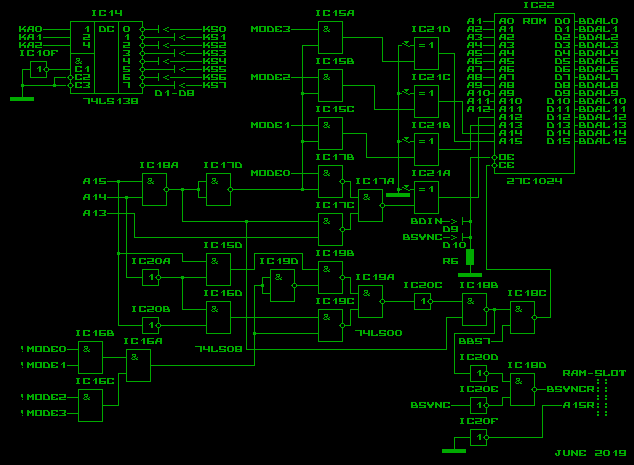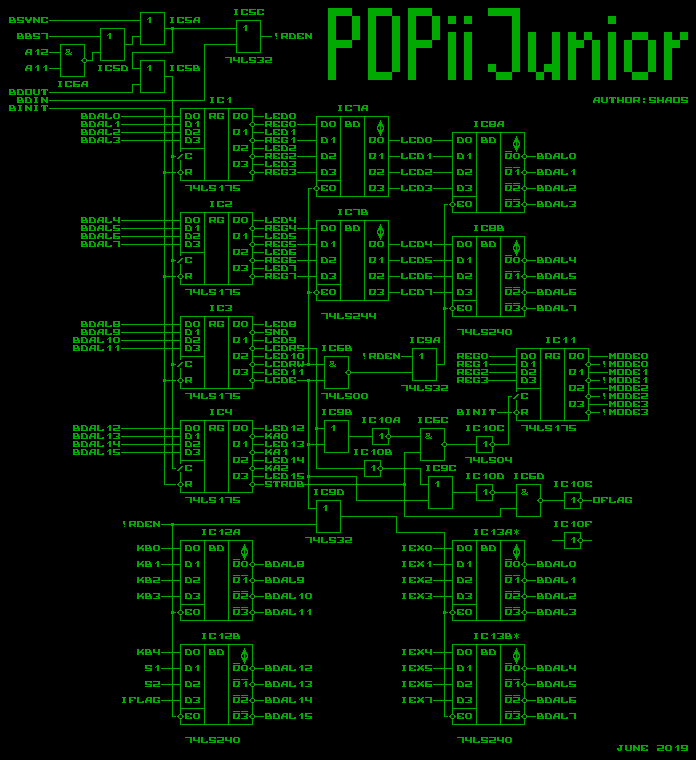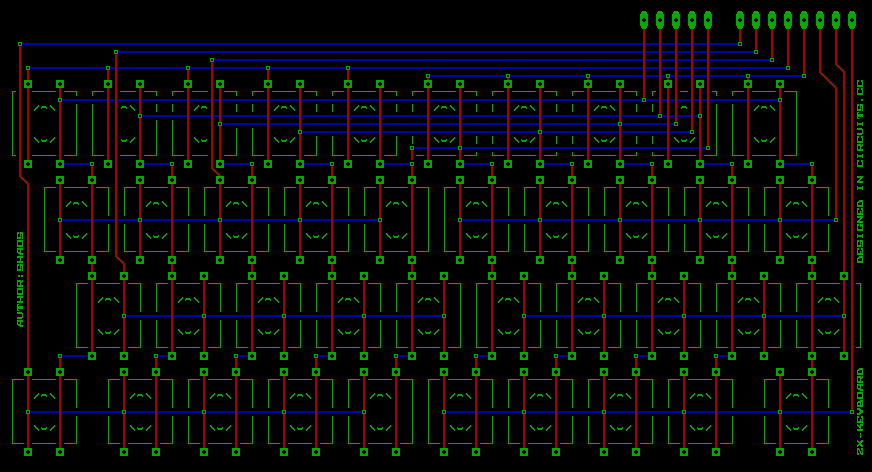-
Board
07/13/2019 at 20:47 • 4 commentsFinished main board design - it's 13.7 x 6.6 inches:
![]()
For the board I used the same Circuits.CC (my online tool for making simple schematics and PCB):
![]()
To make board image more readable I rotated it, moved to grayscale and inverted:
![]()
and even printed in scale (160 dpi) to see if components are fitting well ;)
![]()
Now I need to write C-program to convert my tiled pseudo-ASCII design to Gerbers for production ;)
P.S. Just noticed a few things to fix - probably 1st of all I need to write C-program that is looking for errors like interrupted wires. incomplete pads etc...
-
Last piece of the puzzle
06/29/2019 at 06:45 • 0 commentsFinal part of the logic plus ROM:
![]()
Here you can see how I do address bits manipulation for ROM to have memory models described earlier - now total count of integrated circuits is 22 (plus #PDPii CPU module and #PDPii RAM module). As I said before RAM module will have its own slightly modified BBQ-slot - instead of A15 it will have always "1" and custom BSYNC signal will be used to mask RAM in places where it's not supposed to be located. Also XOR chip IC21 will be used to mix ROM pages (just to be able to boot from any of them).
-
More TTL gates
06/28/2019 at 05:19 • 3 commentsNow it looks much closer to completion:
![]()
IC11 is bank register, that store 4 bits when LCDE=0, LCDRS=0 and STROB=1 for a short period of time and it's cleaned on boot (when BINIT=0). If LCDE=0 and LCDRS=1 then STROB goes out as OFLAG (will be used in future). Higher byte of the word is always going back to the BBQ-bus when !RDEN is 0 (Q-bus read cycle from address 0xF800...0xFFFE), but lower byte can be LCD data output if !RDEN=0, LCDE=1 and LCDRW=1 (read from LCD) or IEX0...IEX7 if !RDEN=0 and LCDE=0 (LCD disabled). Those 8 extra inputs are reserved for future so if it's not used then IC13 could be omited. REG0...REG7 are connected to LCD data bus only when LCDRW=0 (write to LCD).
Next I should add ROM 27C1024 and show how to mix RAM module and ROM address signals with some logic to get memory modes described earlier - TO BE CONTINUED
-
Control register
06/27/2019 at 05:57 • 0 commentsThis is how it could be implemented (drawn in my Circuits.CC online editor):
![]()
As you can see it writes data to register at the end of BDOUT=0 and BSYNC=0 (Q-bus write cycle) when BBS7=0 (it means A15=A14=A13=1) and A11=A12=1 (so technically speaking it will respond on any address from 0xF800 to 0xFFFE, but for future compatibility we are saying that address must be 0xFF00). We will use inverted outputs (REG0...REG15) to fix our inverted data bus and straight outputs will go to 16 LEDs for indication. Also BINIT signal will clean the register on boot (but because we use inverted outputs we will get value 0xFFFF). And finally we have signal !RDEN (read enabled) to connect buffer to databus when CPU reads (BDIN=0 and BSYNC=0 that is Q-bus read cycle) from address 0xFF00 (actual buffer schematics will be added later).
TO BE CONTINUED -
Memory map
06/24/2019 at 01:47 • 1 commentOriginal #PDPii memory modules occupy these address ranges:
- nedoPC-18.10 aka "ROM module 64KWord or 128KB" - 0x0000...0x7FFF or 0x0000...0xFFFF (paging with jumpers);
- nedoPC-18.20 aka "RAM module 32KB" - 0x8000...0xDFFF or 0x8000...0xFFFF (use or ignore /BBS7).
Here I will not use ROM module, because ROM chip 27C1024 will be on motherboard itself with programmable paging (16 pages ROM0...ROM15 8KB each). RAM module will be inserted into dedicated BBQ-slot and split to RAM0 and RAM1 halves (16KB each) that will be connected to memory windows independently with help of some additional logic. So I plan to have 3 BBQ-sockets on that motherboard:
- BBQ-bus+ socket for CPU module;
- BBQ-bus+ socket for RAM module (this socket will be customized BBQ-socket just for RAM);
- BBQ-bus+ socket for any I/O module controllable by /BBS7 signal (for example RC2014 adapter).
Also motherboard will have 16-bit register (probably better to take 4 x 74LS175 to have ability to use inverted bits and clear it on RESET) and 16-bit buffer (inverting 2 x 74LS240) to write/read LCD accessible by address 0xFF00 (or 0177400 in octal system that was "native" for PDP-11). For keyboard addressing it will be 74LS138 decoder chip that converts 3-bit address to 8 control lines (and we will read 5 signals back from keyboard - similar to classic ZX-Spectrum):
![]()
For bank switching we can take 4-bit register and make it accessible with some combination of control bits when LCD is disabled. That bank switching latch will encode memory mode:
Memory
modeWindow 0
0x000...0x3FFFWindow 1
0x4000...0x7FFFWindow 2
0x8000...0xBFFF1st half of Win3
0xC000...0xDFFF0000 ROM0 + ROM1 RAM1 RAM0 ROM0 0001 RAM0 RAM1 ROM0 + ROM1 ROM1 0010 RAM0 RAM1 ROM0 + ROM1 ROM2 0011 RAM0 RAM1 ROM0 + ROM1 ROM3 0100 RAM0 RAM1 ROM0 + ROM1 ROM4 0101 RAM0 RAM1 ROM0 + ROM1 ROM5 0110 RAM0 RAM1 ROM0 + ROM1 ROM6 0111 RAM0 RAM1 ROM0 + ROM1 ROM7 1000 RAM0 RAM1 ROM0 + ROM1 ROM8 1001 RAM0 RAM1 ROM0 + ROM1 ROM9 1010 RAM0 RAM1 ROM0 + ROM1 ROM10 1011 RAM0 RAM1 ROM0 + ROM1 ROM11 1100 RAM0 RAM1 ROM0 + ROM1 ROM12 1101 RAM0 RAM1 ROM0 + ROM1 ROM13 1110 RAM0 RAM1 ROM0 + ROM1 ROM14 1111 RAM0 RAM1 ROM0 + ROM1 ROM15 On reset it will be memory mode 0000 (ROM in window 0 then RAM1 then RAM0) then BIOS will programmatically switch memory mode to something else to have RAM in the 1st half of memory to be able to run RT-11 apps and 1st half of Window 3 will be used to access other ROM pages. 2nd half of Window 3 will always be BBS7 area for peripheral devices inserted into 3rd slot. Also it is possible to add 4 jumper switches to mix ROM pages to start from any ROM page if needed (for debug purposes for example).
Description of every bit of memory location 0xFF00 (LCD control register and keyboard reading):
Bit On write On read 0 LCD data bit 0 (also goes to bank register) LCD data bit 0 1 LCD data bit 1 (also goes to bank register) LCD data bit 1 2 LCD data bit 2 (also goes to bank register) LCD data bit 2 3 LCD data bit 3 (also goes to bank register) LCD data bit 3 4 LCD data bit 4 LCD data bit 4 5 LCD data bit 5 LCD data bit 5 6 LCD data bit 6 LCD data bit 6 7 LCD data bit 7 LCD data bit 7 8 LED output (error) and may be sound (?) Keyboard data bit KB0 9 LCD control input RS (0 - command, 1 - data) Keyboard data bit KB1 10 LCD control input R/W (0 - write, 1 - read) Keyboard data bit KB2 11 LCD control input E (0 - disable LCD, 1 - enable LCD) Keyboard data bit KB3 12 Keyboard address bit KA0 Keyboard data bit KB4 13 Keyboard address bit KA1 Extra button S1 (?) 14 Keyboard address bit KA2 Extra button S2 (?) 15 Extra output (goes to bank register if E=0 and RS=0) Extra input (reserved for future use)
 SHAOS
SHAOS